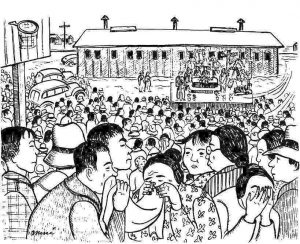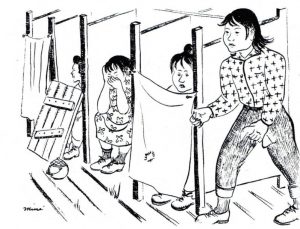Life is hard enough during a child’s high school years under normal circumstances. For Mrs. Uno, her high school years were anything but normal. In February of 1942, President Franklin Roosevelt issued Executive Order 9006, which sent Japanese people on the west coast into internment camps in remote areas of the country. [i] Mrs. Uno was just 13 when this order was put into place. Since she was living in California at the time, she and her family were forced to leave their home and go to an internment camp. This was obviously life-changing for Mrs, Uno.
Mrs. Uno had lived 12 years of her life before internment. This raises questions about how her life was before the internment camps. When thinking of Japanese families living on the west coast in the early 20th century, one probably thinks that they all lived within one community. Mrs. Uno did not live in one of these communities. She actually mentions how she was neighbors with a lovely African American couple and a Jewish couple[ii]. She was very friendly with her neighbors and on several occasions, the Jewish woman would take her into town. The older women made sure to get Mrs. Uno home before curfew. A curfew that was issued for Japanese people on the west coast before the order to intern them were made. [iii]
Once that ordered was made, then off to the camp her and her family went. Mrs. Uno tells the story of her life in the camp a little bit more pleasant than expected. She mentions how some women had an “easier” life in the camps. By easier, she means less work exhaustive than being back home. Back home, women would have to work hard and long days farming. At the camps, they were able to take classes like sewing and painting. Mrs. Uno also mentions that this was her first real experience with Japanese culture. [iv]Since she did not really live in a Japanese community her exposure to her culture was limited. She did go to Japanese school once a week, but this was nothing compared to the exposure when she was in the camp. One thing that really changed Mrs. Uno life that she mentioned was when she went to a sunrise service. While at this service, she felt called by God. Another event that had a major impact on her while in the camp was her father getting sick and dying. Mrs. Uno would go visit her father very often and seeing the nurses care for me made her went to become a nurse.[v]
After she got out of the camp, Mrs. Uno moved to Des Moines, Iowa to finish out high school at Roosevelt High. After high school, she went on to a three-year diploma program and became a nurse. Even until this day almost 80 years later, Mrs. Uno is still very active in her church and started a volunteer program that has reached the federal level.[vi] These two things that happened in camp shaped the rest of Mrs. Uno’s life. In a way, even though getting interned was a terrible thing and should not have happened, getting interned may have set Mrs. Uno up for the life that she lives and loves until this day. How did Mrs. Uno stay so positive to change her life?
From a young child, Mrs. Uno was very optimistic about life. She mentioned how her brother was embarrassed because her family did not a lot of money and fancy things. She responded by saying she had clothes on her back and a roof over her head. She did the best with what she had and did not complain. This pride she said is why the internment camps are not as talked about as much as they should be. Mrs. Uno feels that Japanese people are so prideful and did not want to talk about their painful past. Luckily, the younger generations have made an effort for this period of time not to be forgotten. She mentioned how February is remembrance month and how she went to a big event in Sacramento for it.
Mrs. Uno was a teenager when she went to the internment camps. She did not let this experience affect her in a negative way. She actually had this experience shaped her life in a positive way. This experience could have easily broken someone and made them resent life and everyone. Fortunately, Mrs. Uno did not let this break her down.
[i] Matsumoto, Valerie. “Japanese American Women During World War II.” Women and War, 2016, 530-36. doi:10.1515/9783110971125.444.
[ii] Mrs. Uno, March 26, 2018.
[iii] Mrs. Uno, March 26, 2018
[iv] Mrs. Uno, March 26, 2018
[v] Mrs. Uno, March 26, 2018
[vi] Mrs. Uno, March 26,2018






 [3]
[3] [5]
[5]